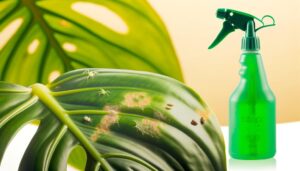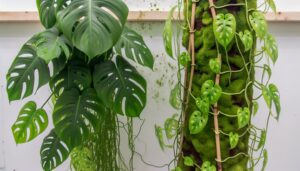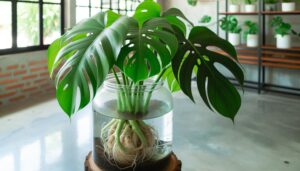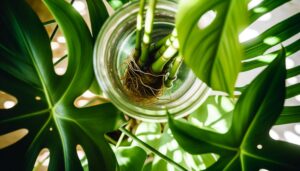Monstera Lechleriana Variegated Care: Complete Guide!
To care for your variegated Monstera Lechleriana, thrive in bright, indirect light is crucial. Maintain peak soil moisture levels without waterlogging.
Use a well-draining, slightly acidic potting mix. Keep humidity levels at 60-80%, utilizing humidifiers or pebble trays.
Temperatures should range between 65°F and 80°F. Fertilize bi-weekly with a balanced 20-20-20 liquid fertilizer during the growing season.
Prune regularly with sterilized tools, removing any damaged leaves. Repot every 2-3 years, choosing pots with proper drainage.
For the best health and growth, fine-tune these practices depending on seasonal variations. Discover additional strategies to perfect your plant care.
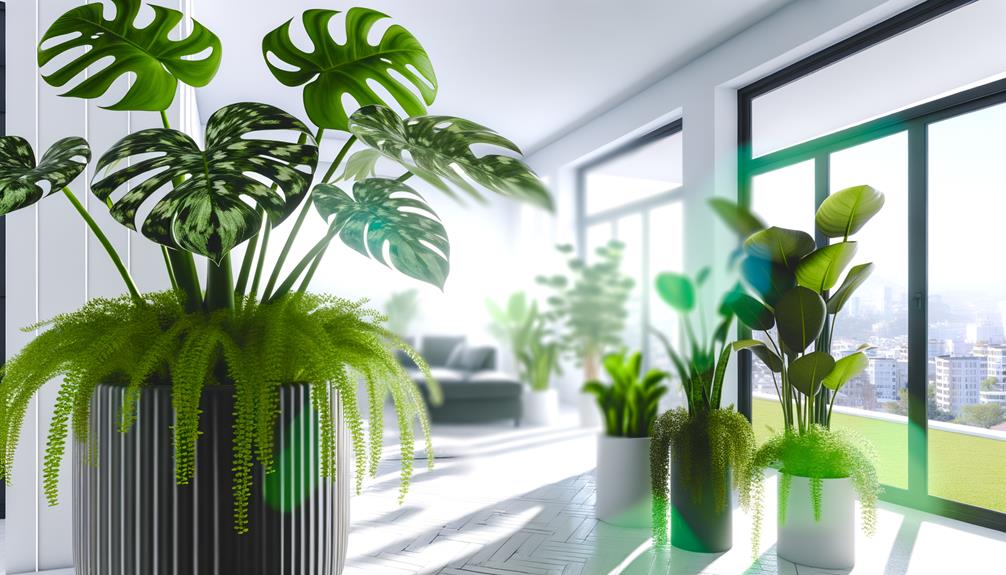
Key Takeaways
- Place in bright, indirect light, avoiding direct sunlight to prevent leaf damage.
- Maintain soil moisture, allowing the top 2 inches to dry out between waterings.
- Ensure humidity levels between 60-80% using humidifiers or pebble trays.
- Fertilize bi-weekly during growing season with a balanced 20-20-20 NPK liquid fertilizer.
- Prune regularly to remove damaged leaves and encourage new growth.
Light Requirements

Monstera Lechleriana Variegated thrives in bright, indirect light to maintain its vibrant variegation and overall health. Position your plant near a north or east-facing window where it can receive filtered sunlight. Direct sunlight can scorch the leaves, causing damage and loss of variegation. You can also use sheer curtains to diffuse the light if your windows receive intense sun.
Artificial grow lights with a color temperature around 6500K can supplement natural light if needed. Guarantee the plant gets at least 10-12 hours of light daily. Insufficient light will lead to slower growth and less pronounced variegation. Regularly rotate the plant to ensure even light exposure and balanced growth. Proper lighting is pivotal for photosynthesis and chlorophyll production.
Watering Schedule
To maintain peak soil moisture levels for your Monstera Lechleriana Variegated, make sure the top inch of soil remains consistently moist but not waterlogged.
You’ll need to adjust your watering frequency based on the seasons, as the plant requires more water during its active growth period in spring and summer.
Monitor the soil closely and reduce watering in fall and winter to prevent root rot.
Optimal Soil Moisture Levels
Ensuring ideal soil moisture levels involves regularly checking that the top inch of soil is dry before watering again. Use your finger to test soil dryness, ensuring it feels dry to the touch.
Monstera Lechleriana Variegated prefers evenly moist soil, avoiding waterlogged conditions which can lead to root rot. Employ a well-draining potting mix, incorporating perlite or orchid bark to enhance aeration. Water thoroughly until excess drains from the bottom, ensuring complete soil saturation.
After watering, allow the soil to dry out slightly before the next session. Consistent moisture promotes healthy root development and leaf variegation. Using a moisture meter can provide more precise readings, ensuring you meet the plant’s hydration needs effectively.
Seasonal Watering Adjustments
How do you adjust your watering schedule to accommodate the changing needs of Monstera Lechleriana Variegated throughout the different seasons?
During the growing season (spring and summer), increase watering frequency. Monitor soil moisture to keep it consistently damp but not waterlogged. Check soil moisture levels using a moisture meter for accuracy.
In contrast, during fall and winter, reduce watering frequency. The plant’s metabolic rate slows, decreasing water requirements. Make sure the top 2 inches of soil dry out between waterings to prevent root rot.
Additionally, consider ambient humidity; higher indoor heating in winter can dry the air, necessitating periodic misting to maintain peak humidity levels.
Tailoring your watering schedule seasonally guarantees the plant thrives year-round.
Soil Preferences
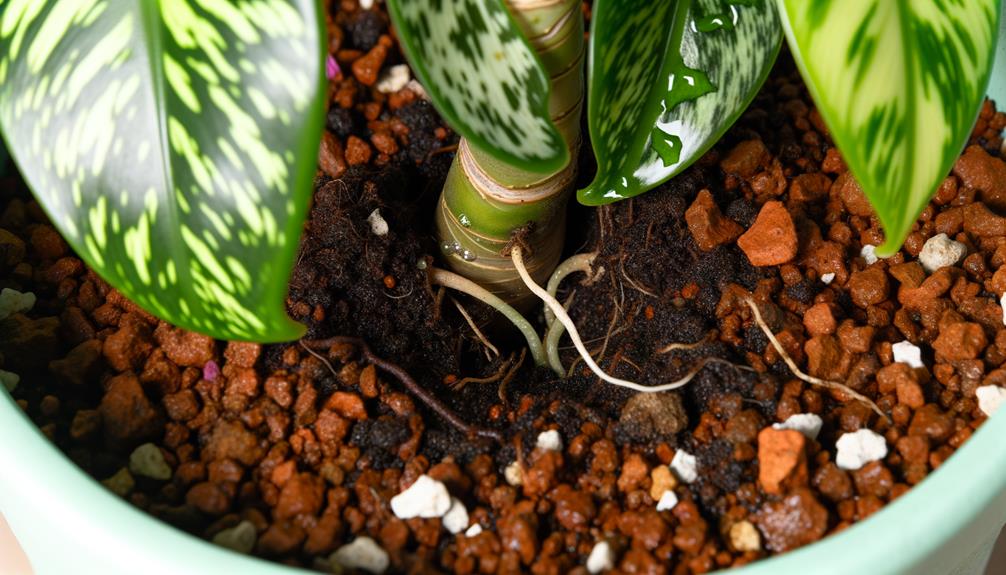
Choosing the right soil for your Monstera Lechleriana Variegated is crucial, as it thrives in a well-draining, aerated mix that mimics its natural tropical habitat. The best soil mix should facilitate root oxygenation and prevent waterlogging, which can lead to root rot.
Incorporate materials that enhance drainage and aeration:
- Pine Bark: Provides structure and enhances drainage.
- Perlite: Improves soil aeration and prevents compaction.
- Coconut Coir: Retains moisture without becoming waterlogged, offering a balanced medium.
- Activated Charcoal: Helps with drainage and reduces the risk of pathogens.
Ensure the soil pH remains slightly acidic to neutral (5.5-7.0) to enhance nutrient uptake. Regularly check soil conditions to maintain the ideal environment for robust growth.
Humidity Needs
For best growth, your Monstera Lechleriana Variegated requires a humidity level of 60-80%.
If your environment is too dry, you can employ strategies like using a humidifier or placing a tray of water near the plant to increase humidity.
Regularly monitor the humidity with a hygrometer to guarantee it stays within the ideal range.
Ideal Humidity Levels
Maintaining ideal moisture levels, ideally between 60-80%, is crucial for the health and variegation of your Monstera Lechleriana. Consistent moisture supports cellular functions, preventing leaf browning and encouraging vibrant variegation. To guarantee your plant thrives, monitor and regulate the moisture in the air.
High moisture facilitates best transpiration and nutrient uptake processes. Factors to bear in mind include:
- Moisture Sensors: Utilize digital hygrometers for accurate readings.
- Water Sources: Place water trays near the plant to increase local moisture.
- Leaf Condition: Regularly inspect leaves for signs of dryness or stress.
- Air Circulation: Ensure adequate air movement to prevent mold growth and maintain even moisture distribution.
Adhering to these guidelines will greatly enhance the vitality and aesthetic appeal of your Monstera Lechleriana.
Increasing Humidity Strategies
To effectively increase humidity for your Monstera Lechleriana, employ techniques such as misting, using humidifiers, and grouping plants together. By misting the leaves, you provide immediate moisture to your plant. Humidifiers are particularly effective as they maintain consistent humidity levels, ideal for tropical plants. Grouping plants creates a microenvironment with higher humidity due to collective transpiration.
| Technique | Description |
|---|---|
| Misting | Spraying water on leaves to add moisture |
| Humidifier | Device that releases water vapor into the air |
| Grouping Plants | Placing plants close together to boost local humidity |
| Pebble Trays | Trays with water and pebbles to increase ambient humidity |
| Room Placement | Positioning plants in rooms with naturally higher humidity |
Each method contributes to mimicking the Monstera’s native tropical environment, promoting healthy growth.
Monitoring Humidity Regularly
Regularly monitoring the humidity levels around your Monstera Lechleriana is essential for ensuring the plant receives the best moisture it needs for healthy growth. Aim for humidity levels between 60% and 80%. Use a hygrometer to measure the moisture in the air accurately. If levels drop below the ideal range, you can take corrective actions.
- Use a humidifier: Place it near the plant to maintain consistent humidity.
- Mist the leaves: Lightly misting can provide temporary relief.
- Humidity trays: Fill trays with water and pebbles, placing them under the plant pot.
- Group plants together: This creates a microenvironment with higher humidity.
Temperature Range
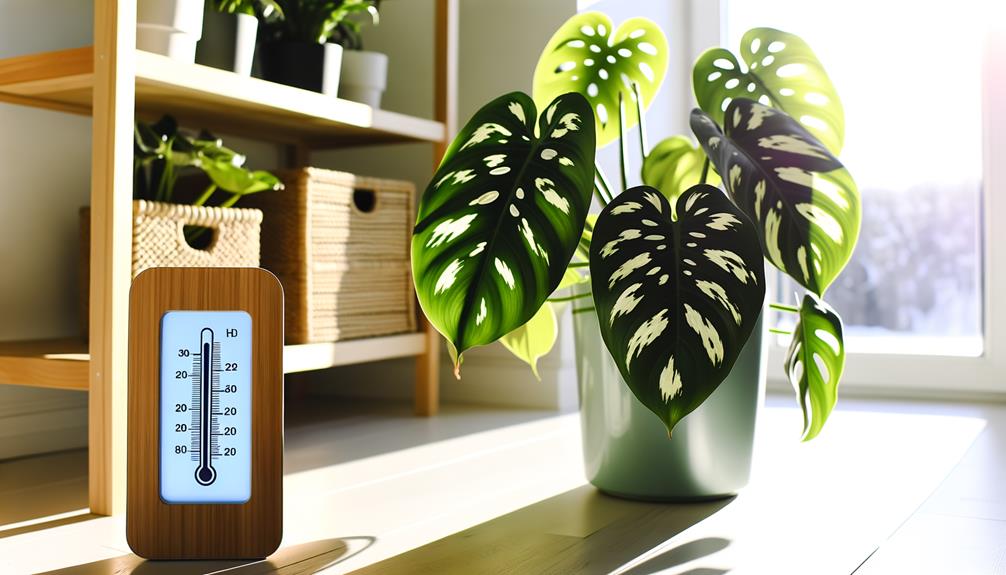
The perfect temperature range for Monstera Lechleriana Variegated is between 65°F and 80°F, ensuring excellent growth and variegation retention. Maintaining this range is vital as temperatures below 55°F can stunt growth and affect leaf coloration. High temperatures above 85°F can cause leaf scorch and stress the plant. Use a digital thermometer to monitor your indoor environment accurately.
Here’s a quick reference table:
| Temperature (°F) | Growth Impact | Recommendation |
|---|---|---|
| Below 55 | Stunted growth | Avoid prolonged exposure |
| 65 – 80 | Ideal growth | Ideal range |
| Above 85 | Leaf scorch | Increase ventilation |
Fertilizing Tips
When fertilizing your Monstera Lechleriana Variegated, choose a balanced liquid fertilizer with an N-P-K ratio of 20-20-20 for best nutrient absorption.
Apply the fertilizer bi-weekly during the growing season, which usually lasts from spring to early autumn.
Make sure you dilute the fertilizer to half-strength to prevent root burn and nutrient overload.
Optimal Fertilizer Types
Choosing a balanced, slow-release fertilizer with a 20-20-20 NPK ratio provides essential nutrients for the growth and variegation of Monstera Lechleriana. This type of fertilizer guarantees an even distribution of nitrogen, phosphorus, and potassium, vital for robust leaf development and vibrant variegation.
To maximize the benefits, consider the following attributes when selecting your fertilizer:
- Chelated Micronutrients: Enhances nutrient uptake and prevents deficiencies.
- Organic Matter: Promotes soil health and microbial activity.
- Water-Solubility: Ensures the fertilizer dissolves effectively in soil moisture.
- Controlled-Release Mechanism: Provides a steady nutrient supply over time.
Seasonal Feeding Schedule
To maximize growth and variegation of Monstera Lechleriana, adjust your fertilizing routine according to the plant’s seasonal needs. During the active growing season, typically spring and summer, apply a balanced, water-soluble fertilizer every 2-4 weeks. Opt for a formulation with essential macronutrients: nitrogen (N), phosphorus (P), and potassium (K).
As temperatures drop in fall and winter, reduce feeding frequency to once a month or halt it entirely. The plant’s metabolic rate slows, decreasing nutrient uptake. Watch for signs of over-fertilization, like leaf burn or salt buildup in the soil.
Consistent adjustment based on seasonal changes ensures the best nutrient provision, promoting lush foliage and maintaining variegation integrity. Always tailor your approach to the plant’s specific environmental conditions.
Application Best Practices
Promoting best nutrient absorption for your Monstera Lechleriana involves applying fertilizer at the right time and in the correct manner. For peak growth, use a balanced, water-soluble fertilizer diluted to half strength. Apply during the active growing season, typically spring and summer, guaranteeing even distribution. Avoid fertilizing in fall and winter when growth slows.
For precision, consider the following best practices:
- Frequency: Fertilize every 4-6 weeks during active growth.
- Application: Use a water-soluble fertilizer mixed with irrigation water.
- Even Distribution: Make sure the fertilizer solution is evenly distributed around the root zone.
- Monitoring: Regularly check leaf color and growth patterns to adjust fertilization as needed.
These steps optimize your Monstera Lechleriana receives the essential nutrients for vigorous growth.
Pruning Guide
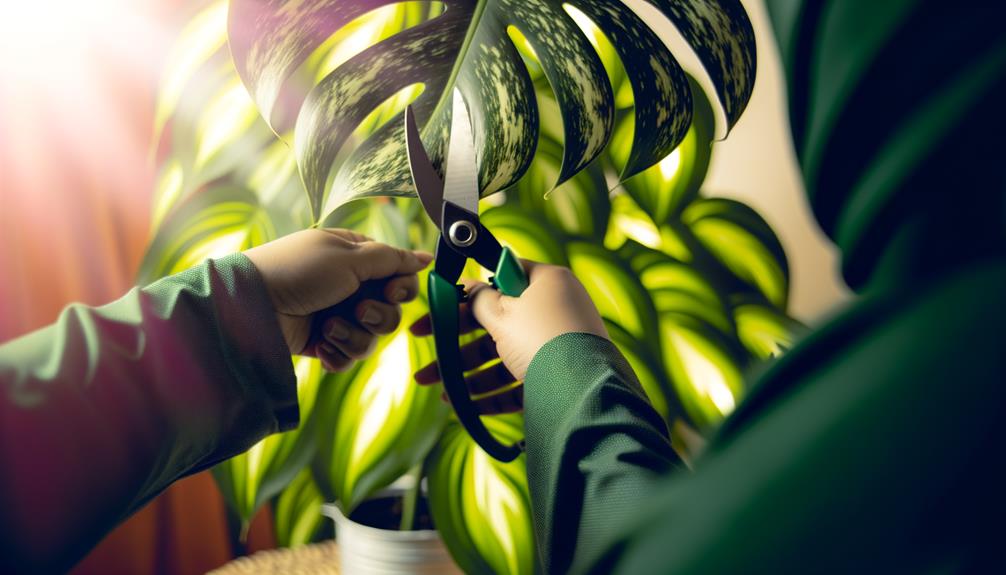
Proper pruning of your Monstera Lechleriana Variegated not only maintains its aesthetic appeal but also promotes healthier growth by removing damaged or unnecessary foliage. Start by sterilizing your pruning tools to prevent disease transmission. Focus on removing yellow, brown, or damaged leaves, as these can hinder growth. Cut just above a node to encourage new growth while maintaining the plant’s shape.
Here’s a detailed pruning guide:
| Task | Description |
|---|---|
| Sterilize Tools | Use rubbing alcohol to clean shears or scissors. |
| Identify Leaves | Look for yellow, brown, or damaged leaves. |
| Make the Cut | Cut above a node to promote new growth. |
| Dispose of Debris | Remove pruned leaves to prevent mold and pests. |
Regular pruning keeps your Monstera vibrant and thriving.
Repotting Instructions
Repotting your Monstera Lechleriana Variegated guarantees it has ample space for root expansion and nutrient absorption, essential for robust growth. Begin by selecting a pot that’s 2-3 inches larger in diameter than the current one. Confirm the new pot has adequate drainage to prevent root rot. Prepare a well-aerated, chunky potting mix, rich in organic matter.
Gently remove the plant from its existing pot, shaking off excess soil, and inspect the roots for any signs of disease or damage. Tools required: clean shears, fresh potting mix, new pot, gloves. Optimal timing: spring to early summer, during active growth phase.
Inspect root health and trim any damaged or diseased roots. Watering after repotting: thoroughly water to settle the soil.
Repotting secures your plant thrives in its new environment.
Pest Control
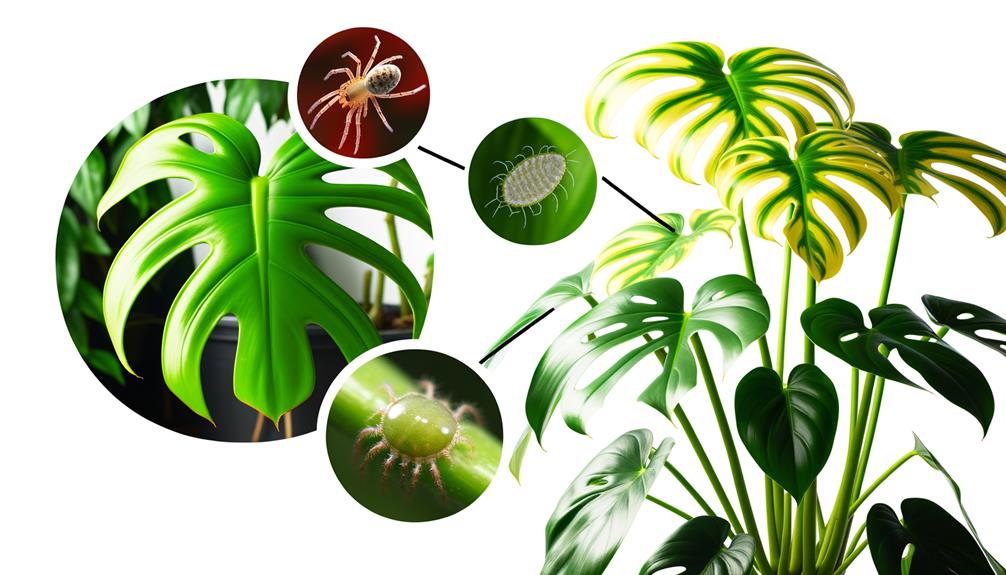
To safeguard your Monstera Lechleriana Variegated from common pests like spider mites, aphids, and mealybugs, it’s vital to regularly examine the foliage and stems for any signs of infestation. Search for discolored spots, webbing, or sticky residue. Utilize a magnifying glass to identify tiny pests.
If you detect pests, isolate the plant immediately to prevent spreading. Apply insecticidal soap or neem oil, ensuring thorough coverage on both sides of the leaves. Furthermore, maintain proper humidity levels and avoid overwatering, as pests thrive in moist conditions.
Routinely wipe down leaves with a damp cloth to eliminate dust and potential eggs. Consistent monitoring and prompt action are essential for maintaining your Monstera healthy and pest-free.
Common Diseases
Identifying common diseases early on is essential for maintaining the health and vigor of your Monstera Lechleriana Variegated. Bacterial and fungal infections can have a significant impact on your plant.
Key diseases to watch for include:
- Bacterial Leaf Spot: Look for water-soaked lesions that turn brown and spread rapidly.
- Root Rot: Typically caused by overwatering, you’ll notice mushy, blackened roots and yellowing leaves.
- Powdery Mildew: This fungal disease presents as a white, powdery substance on leaves, leading to distorted growth.
- Anthracnose: Characterized by dark, sunken lesions on leaves and stems, it can cause severe defoliation.
Regularly inspect your plant, maintain proper watering practices, and promote good air circulation to reduce the chances of these issues.
Early intervention is crucial for safeguarding your Monstera’s health.
Propagation Methods
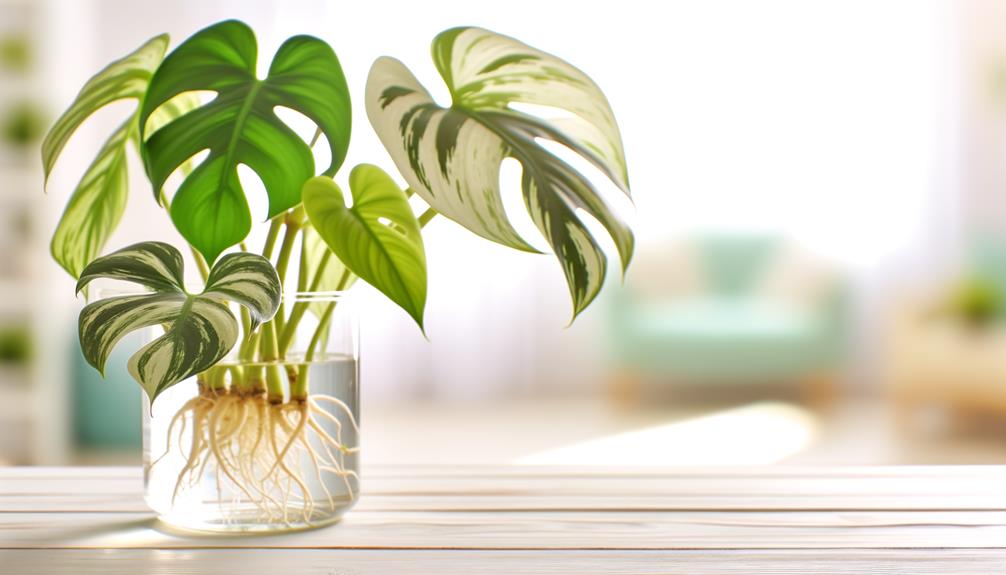
Successfully propagating Monstera Lechleriana Variegated requires a detailed understanding of stem cutting techniques and ideal rooting conditions.
First, select a healthy stem with at least one node and aerial root. Using sterilized pruning shears, make a clean cut just below the node. Immerse the cut end in a rooting hormone to encourage faster root development.
Place the cutting in a container with water or a well-draining soil mix, ensuring the node is submerged. Maintain consistent moisture and humidity levels, ideally around 70-80%. Position the container in indirect light, avoiding direct sunlight, which can scorch the cutting.
Regularly monitor for root growth, which typically begins within 2-4 weeks. Once roots are established, transplant to a larger pot with suitable soil.
Seasonal Care
Proper seasonal care for Monstera Lechleriana Variegated promotes optimal growth and health all year round.
In spring and summer, elevate watering regularity to support active growth. Supply indirect, intense light to maximize photosynthesis without scorching the leaves.
During fall and winter, decrease watering but guarantee the soil remains slightly damp to prevent root rot.
Sustain humidity levels around 60-70% throughout the year.
Monitor for pests and diseases.
Conclusion
Caring for your enchanting, diverse Monstera lechleriana demands dedication and thoughtful deliberation. Consistently offer ample, indirect light, uphold a careful watering routine, and maintain a meticulous soil aeration. Adequate humidity and warmth are crucial; strive for a moist, cozy environment.
Vigilantly fend off pests and preempt diseases to maintain the immaculate condition of your plant. Propagate with accuracy, and adapt care according to the season. Your attentive commitment will be repaid with a flourishing, visually impressive specimen that serves as a tribute to your botanical knowledge.

